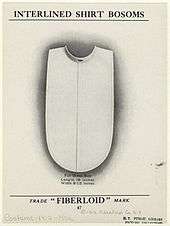Dickey (garment)

A dickey (alternatively written as dickie or dicky;[1] sometimes known in American English as a tuxedo front or tux front) is a type of false shirt-front - originally known as a detachable bosom - designed to be worn with a tuxedo or men's white tie, usually attached to the collar and then tucked into the waistcoat or cummerbund. Better dickeys have a trouser tab at the end to secure them down, preventing the dickey from popping out. The rigid plastic dickey came into fashion in the latter years of the 19th century, and was one of the first successful commercial applications of celluloid.
The invention of the dickey was to make the bosom front of a full dress shirt a separate entity in itself, like the detachable collar, so it could be laundered and starched more easily than a traditional shirt with the bosom attached. The use of the dickey was considered bad style by traditionalists and had fallen out of use. Shirts with an attached bosom are now rare in themselves since traditional evening dress is no longer regularly worn.
The etymology can be attributed to Cockney rhyming slang where a "dicky dirt" is a shirt.
Dickeys – celluloid, cardboard, and cloth
Celluloid (hard plastic)
Celluloid dickeys were popular for their waterproof and stain-resistant properties. Unlike traditional cloth shirt-fronts, they remained sleek, bright white, and did not wilt or wrinkle. Celluloid dickeys simulated the look of a formal shirt bib for day and evening wear. They were designed in a variety of patents, such as: rounded, flat-end, no restraints, a restraint tab at the end of the bib or side straps that tied at the wearer's back. For this reason, they were popular with entertainers, musicians, and other performers. Nevertheless, they were frequently maligned and spoofed for their stiffness, unmanageability, and tendency to pop out of place. In one notable Looney Tunes segment, Bugs Bunny conducts an arrogant opera singer and makes him hold a note so long that his dickey snaps out of his waistcoat and rolls up to his throat. "The flapping dickey", a famous Vaudeville cliché, involves a dickey which has been intentionally rigged to flap in a comical fashion.
Cardboard
Cardboard dickeys were worn in theater and service professions to save money from using linen formal shirts for uniforms. Examples of professions that used cardboard dickeys include waiters, hotel managers, doormen, bellboys, limo drivers, and servants. Cardboard dickeys are still manufactured in the United States by Amazon Drygoods.
Cloth
Cloth dickeys simulate many different styles, some often seen examples include dress shirt front and collar, formal frilled shirt front (popular in the mid seventies with powder blue tuxedos) and most commonly in modern times as false turtleneck sweater fronts. Cloth dickeys are also often used in marching band uniforms.
Hard plastic dickeys have long since gone out of manufacture and fashion, but cloth turtleneck-style dickeys are still sometimes seen, for example on the TV series The Big Bang Theory, worn by the character Howard Wolowitz, as well as in Dinner for Schmucks, where the character Therman Murch (played by Zach Galifianakis) wore an orange turtleneck dickey. Cousin Eddie (played by Randy Quaid) in "National Lampoon's Christmas Vacation" wore a dark green turtleneck dickey underneath an ivory sweater. The character Liz Lemon wore a "sweater" type dickey on the opening episode of season 6 on the TV series 30 Rock.[2]
See also
References
- ↑ Merriam-Webster, Oxford English Dictionary
- ↑ Monteagudo, Jennifer. "'30 Rock' Recap: 'Dance Like Nobody's Watching'". 30 Rock.